A voltage source is an essential component of any electrical circuit. It provides the electrical potential difference that drives current through the load. Depending on its characteristics, a voltage source can be ideal or practical. Understanding the difference between an ideal voltage source and a practical voltage source helps in analyzing real-world circuits more accurately.
What is an Ideal Voltage Source?
An ideal voltage source is capable of maintaining a constant voltage across its terminals. The voltage across the voltage source terminals remains constant, and the voltage is independent of the current. The symbol of the voltage source is given below.
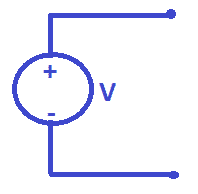
The voltage across the terminals of an ideal voltage source stays constant and does not drop even when the circuit current increases. The graph below shows how the voltage of an ideal source remains unchanged with varying circuit current.
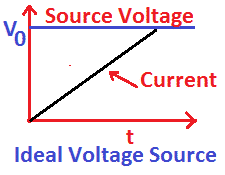
The voltage of an ideal voltage source remains constant if there is no voltage drop across its internal resistance. A voltage source has a certain resistance, which causes a voltage drop across its internal resistance. An ideal voltage source must have zero internal resistance. In this condition, the voltage across the load will be equal to the voltage across the terminals of the voltage source.
Internal Resistance of an Ideal Voltage Source
An ideal voltage source can maintain constant voltage across its terminal from a no-load to a full-load condition. The diagram below shows an ideal voltage source circuit.
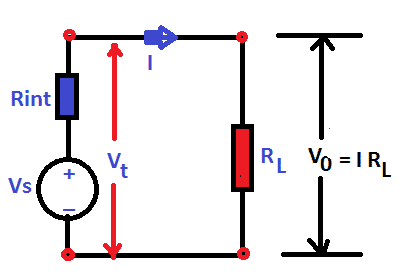
The voltage across the load (Vo) is equal to the voltage across the terminal voltage (Vt) of an ideal voltage source.
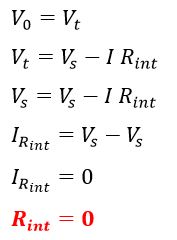
Thus, the internal resistance of an ideal voltage source is zero. The source voltage is equal to the voltage across the load, and no voltage drop occurs in the internal resistance.
What is a Practical Voltage Source?
The internal resistance of an ideal voltage source is zero. However, a practical voltage source has some internal resistance. The symbol of the practical voltage source is depicted below.
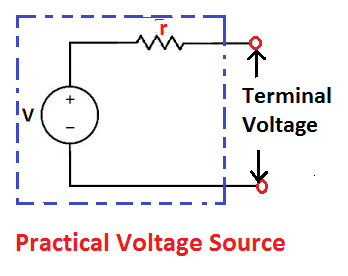
The internal resistance (r) of an ideal voltage source is zero. However, practically, the voltage source has some internal resistance. The symbol of the practical voltage source is depicted below.
The terminal voltage at the source when current is delivered to the load no longer remains constant. The voltage at the source terminal is slightly less than the terminal voltage at no load condition. The practical voltage source at load condition is depicted below.
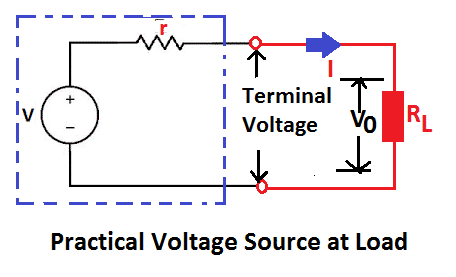
The voltage across the load can be calculated by applying Kirchhoff’s Voltage Law (KVL). According to KVL, the algebraic sum of the voltages in a loop equals zero.
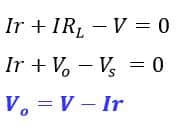
When a practical voltage source delivers current, the voltage across the load is always slightly less than the source voltage. This difference depends on the current flowing through the circuit.
The load voltage equals the source voltage minus the drop caused by the internal resistance. As the circuit current increases, the voltage drop in the internal resistance also increases, reducing the voltage across the load. The graph below illustrates this behavior clearly.
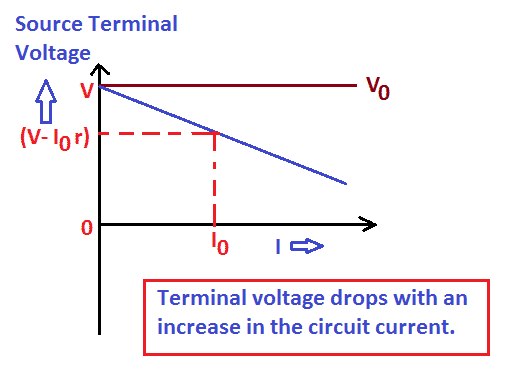
Difference between Ideal & Practical Voltage Source
| Parameter | Ideal Voltage Source | Practical Voltage Source |
| Internal Resistance | Zero | Non-zero (finite) |
| Voltage at Load | Constant and equal to source voltage | Slightly less than source voltage |
| Current-Voltage Relation | Independent | Dependent on internal resistance |
| Power Loss | Zero | Exists due to internal resistance |
| Practical Example | Theoretical concept | Battery, generator, or DC supply |
Conclusion
An ideal voltage source is a theoretical concept that maintains a constant voltage regardless of the load or the current drawn. In reality, every voltage source has some internal resistance, which causes a voltage drop when current flows. This makes practical voltage sources slightly less efficient than ideal ones.
Understanding the difference between ideal voltage sources and practical voltage sources helps engineers and students analyze real-world circuits more accurately. While ideal sources simplify circuit analysis, practical sources represent how actual devices like batteries and generators behave under load conditions.
Related Articles: